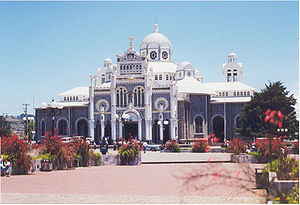Cartago, Costa Rica
Cartago
Cartago | |
|---|---|
| Nickname: La Ciudad de las Brumas | |
| Motto(s): "Fide et pace" (For the faith and the peace) | |
| Country | Costa Rica |
| Province | Cartago Province |
| Canton | Cartago Canton |
| Founded | 1563 |
| Capital City until | 1823 |
| Government | |
| • Mayor | Lic. Rolando Rodríguez Brenes(PLN) |
| Area | |
| • City | 152.68 km2 (58.95 sq mi) |
| Elevation | 1,435 m (4,707 ft) |
| Population (2008) | |
| • City | 156,600(2) |
| • Metro | 413,505 (2) |
| Time zone | UTC-6 (Central Standard Time) |
| Website | http://www.muni-carta.go.cr [2] |
| HDI (2005) 0.813 – high | |
Cartago is a city in Costa Rica, about 25 km (15 miles) east of the capital, San José. It is at an elevation of about 1435 m (some 4930 ft) above sea level on the Cartago River, at the base of the Irazú Volcano. Cartago is the capital of Cartago province. The city covers an area of 152,68 km². It includes the districts of city downtown: Oriental, Occidental (known as the typical downtown area), San Nicolás (the main entrance to the city, at west), El Carmen (north), San Rafael de Oreamuno (at east, is the capital of canton of Oreamuno), Dulce Nombre and San Francisco (at south, San Francisco is known commonly as Aguacaliente). In 2008 the city will have a population of 156,600 inhabitants, according to the Institute of Stadistics and Census of Costa Rica.
History

Cartago was founded in 1563 by Spanish conquistador Juan Vásquez de Coronado, and is the oldest still existing Spanish settlement in Costa Rica. The city was granted a coat of arms by King Philip II of Spain in 1565, and the title of Muy Noble y Muy Leal ("Most Noble and Most Loyal") by the Cortes (Spanish Parliament) in 1814. It served as the first capital of Costa Rica until 1823, when Republican leader Gregorio Jose Ramirez , moved the capital to the bigger city of San José, because Cartago wanted to unite the newly independent province of Costa Rica to the Iturbide's Mexican Empire while San Jose and Alajuela supported a Republican system. The city was severely damaged by major earthquakes in 1822, 1841 and 1910. In 1963, a volcanic eruption of Irazu Volcano which for two years covered San José in ash badly damaged some agricultural areas around Cartago, but not the city.
Many pilgrims come to Cartago annually, to visit the national's principal church, the enormous Basílica de Nuestra Señora de Los Ángeles, on the feast day of the Virgin of the Angels (August 2). The church has a statue of the Black Madonna known as La Negrita, who supposedly had great healing powers. The sick come to her statue in hope of a miracle from La Negrita.
According to folklore in Costa Rica, the statue was found by a mulatto woman in 1635. The rock where she founded it is kept in a backroom in the basilica and is revered as a sacred relic and object of inspiration. The rock is supposed to be in the same location it was when La Negrita was founded, but it has been moved as the basilica was rebuilt (see below). It is common for pilgrims to touch the rock in reverence.
The central park in Cartago includes the "ruins" of the main church of Cartago (the "parroquia" of Santiago Apóstol), about five block west from the basilica. Despite their beauty, they are not real ruins but an unfinished building, which was badly damaged by the 1910 earthquake and then interrupted. The city's government is declaring 100 blocks as "the Cartago's historical center." This is a way to keep the historical buildings alive in the future, as many cities in the world have done. In the other hand, the Government of the city and JASEC (the company that offers the electrical service in the city) has been working both to light some of the most important historical buildings and to attract inhabitants and tourists to the city at night.

The main products of the region are potatoes, onions, milk, and orchids. These used to support more than 90% of the city's economy although other resources such as computer technologies have risen since the last decade.
The province is known for its rich ecological diversity and dense tropical rainforests along the mountain ranges near the Irazu and Turrialba volcanoes.
Cartago is home of the Costa Rica Institute of Technology, one of the most prestigious higher education institutions in the country and one of Central America's most important engineering schools.
| Climate data for Cartago | |||||||||||||
|---|---|---|---|---|---|---|---|---|---|---|---|---|---|
| Month | Jan | Feb | Mar | Apr | May | Jun | Jul | Aug | Sep | Oct | Nov | Dec | Year |
| Source: Instituto Meteorológico Nacional[1] | |||||||||||||
Cities (Included in Cartago Metropolitan Area)
The so-called Ruins in Cartago, currently a local tourist attraction, were intended to be the Santiago Apóstol Church. It has never been the first Basilica. The Basilica was originally built in La Puebla de los Pardos, today known as Barrio Los Ángeles, where it is nowadays.
See also
9°52′N 83°55′W / 9.867°N 83.917°W
- ^ | url = http://www.imn.ac.cr/IMN/MainAdmin.aspx?__EVENTTARGET=ClimaCiudad&CIUDAD=9 | title = Instituto Metereológico Nacional |fechacceso= Marzo 11|añoacceso= 2008 |editorial= |idioma= Spanish}}
